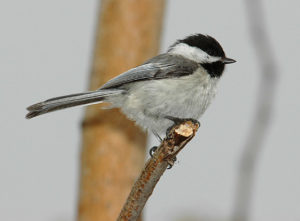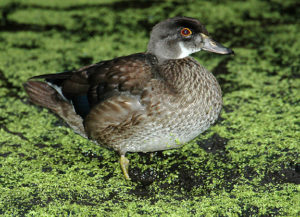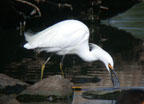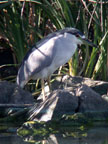Saturday was the day of the Black-capped Chickadees. As we left the welcome center we immediately were surrounded by a little group consistently calling to one another. Now that breeding season is pretty much over with just a few ragtag juvenile birds still harassing their parents for a hand-out (or beak-out), the time for singing is pretty much past. We only heard the distinctive, pure two-note whistled “feebee” a couple of times. Mostly we heard the “chickadee-dee-dee” calls or abbreviated variations. There is one additional call that Black-capped Chickadees make which I wanted to call to your attention, and we heard it a lot on Saturday. It’s a relatively quiet contact call that the chickadees use to stay in touch with one another.
One other cool bird that showed up with the chickadees was a Red-breasted Nuthatch. These guys are primarily found in coniferous forests up in the mountains, but in the fall and winter a few will move down into the conifers that have been planted in parks and residential areas. It was singing consistently doing its rather monotonous “red-red-red-red” series (both recordings (c) xeno-canto.org).
Once again, this summer Wood Ducks successfully fledged young on the pond immediately below the welcome center, and we were able to get good looks at six juveniles, all of whom were apparently males. We’re right on that cusp when juvenile Wood Ducks are starting to take on some of the plumage attributes of adult birds, and all of our birds had the beginnings of the bright white “bridle” so distinctive in the males – finger-like extensions from the white throat on to the cheek and neck. However, our birds also had bright white rings around their eyes, an attribute of their appearance as youngsters.
Moving on down to the South Platte we saw scores of Mallards. The males were all clearly still in eclipse plumage – that time of year when male plumage is very like female – and the only way to tell who were the boys and who were the girls was to look at the bill color – males = yellow-green and females = orange with black splotchiness. The only other duck we saw was a single female Gadwall. A reminder to you all, that as fall migration really gets cranking we could see over ten species of ducks on one of our Hudson hikes, and some of our Front Range Birding Walks on the first Saturday of each month will target areas where we could get over fifteen species.
Finally, shorebird migration through eastern Colorado is at its peak right now, with over twenty species generally recorded each year. We were fortunate on Saturday to see a Spotted Sandpiper (white in front of the wing, and with an obvious bobbing motion) and a Solitary Sandpiper (white “spectacles,” and relatively dark back).
Good Birding!
Chuck
Hudson Gardens, Aug 31, 2019
28 species
Canada Goose 13
Wood Duck 6
Gadwall 1
Mallard 48
Rock Pigeon 2
Broad-tailed Hummingbird 1
Spotted Sandpiper 1
Solitary Sandpiper 1
Ring-billed Gull 53
Great Blue Heron 1
Snowy Egret 2
Black-crowned Night-Heron 1
Red-tailed Hawk 1
Belted Kingfisher 1
Downy Woodpecker 1
Northern Flicker 5
Blue Jay 1
Black-billed Magpie 1
American Crow 3
Black-capped Chickadee 24
Barn Swallow 2
Red-breasted Nuthatch 1
White-breasted Nuthatch 1
House Wren 3
American Robin 2
House Finch 20
American Goldfinch 7
Yellow Warbler 1






Comments
Write Comment